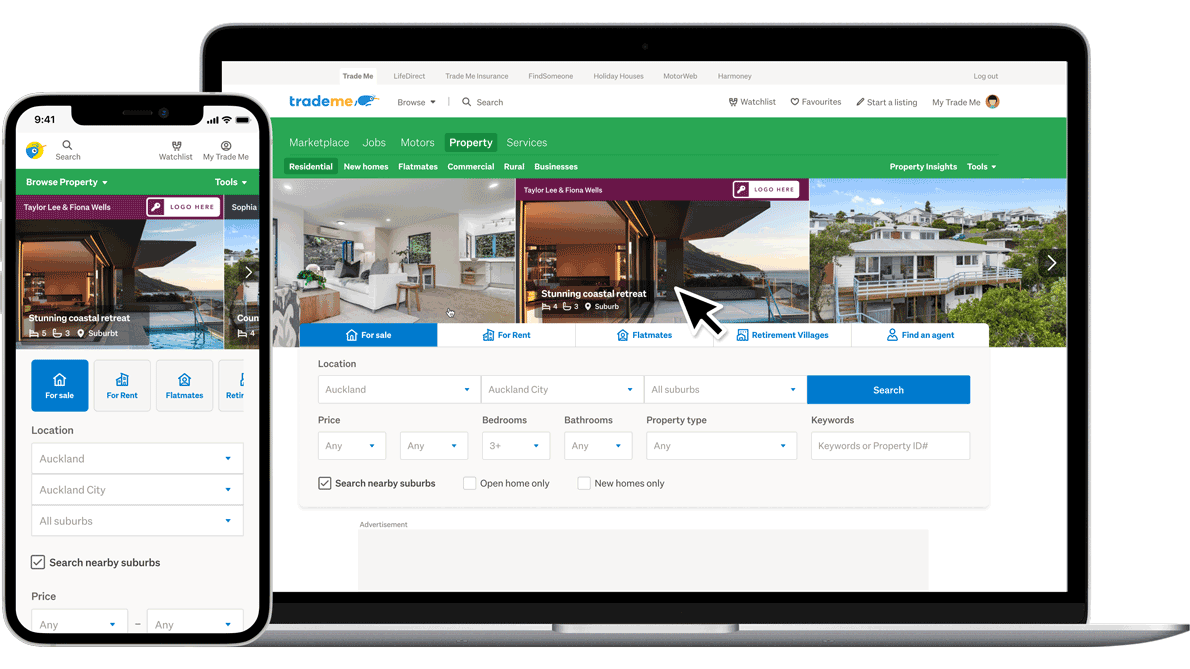Designing a new pricing package for TradeMe Property
My Impact
Led the user research phase to uncover key insights about real estate agents' needs and validate hypotheses through targeted research.
Collaborated with stakeholders, including product managers and sales teams, to ensure alignment with both user and business goals.
Refined placement strategies to enhance property listings' visibility and impact.
Contributed to a 10x growth in Platinum package sales within the first month of launch.
Demonstrated the ability to tackle complex challenges, design user-focused solutions, and deliver measurable results within tight timeframe.
Background
Trade Me Property dominates New Zealand's digital real estate marketing landscape. Most houses in the country are sold through Trade Me Property, with many real estate agents stating their confidence in it as their sole necessary marketing tool.
The platform offers four advertising packages—Basic, Bronze, Silver, and Gold. The concept is simple: the higher the tier, the more visibility, reach, and features you get. However, we noticed agents were still spending heavily on other marketing channels.
This raised an obvious question: Is there room for a premium package beyond Gold? And if so, what features would agents actually pay extra for? What unmet needs leads to spend on other channels?
Objective
Increase the Average Revenue Per User (ARPU) by introducing a higher-priced package offering customers more value for money.
Discovery
We kicked things off with a brainstorming session, digging into existing insights and identifying gaps we needed to address. We started by digging into the needs of both the business and real estate agents:
Stakeholder Collaboration: I worked closely with product managers, sales teams, data analysts, and account executives looking for opportunities to add value. They provided valuable insights into what might resonate with agents.
Research & Insights: Through desk research, past studies, and one-on-one conversations with agents and buyers, we explored their workflows, needs, goals, and challenges.
Hypotheses:
Agents value exposure and reach more than hyper-targeted advertising.
Agents value targeted advertising more than wider reach.
The Gold package is saturated; with too many people buying this package, those listings don't stand out enough.
Gold package buyers are more likely to buy the Platinum package.
We can wean agents off print advertising and incentivize them to spend that budget with us instead.
Trade Me’s data can be leveraged to push listing ads to social media, but how valuable is it?
There must be scenarios where at least some agents wish they had additional superpowers on Trade Me — what would those be?
User Research
To test these hypotheses, we turned to user research. My role was to lead this phase, ensuring we understood user needs, frustrations, and opportunities to create a package that would motivate agents to invest more with us.
Target Audience: We focused on agents already subscribed to the Gold package. Why? If they’re already opting for the best, they’re the most likely to want something even better.
Structure: We held 1:1 interviews with real estate agents, each lasting an hour. In the first half, we explored their experiences with the Gold package, other advertising methods, and their thoughts on ROI across different mediums. In the second half, we tested concepts for the potential new package, gathering their feedback to shape the final product.
Key Findings💡
Agents value exposure and reach more than hyper-targeted advertising — 🟢 Validated. They get value from brand recognition with wider reach.
Agents value targeted advertising more than wider reach — 🔴 Invalidated. This was desired in some scenario, but they prefer wider reach to targeted.
The Gold package is saturated, and listings don’t stand out enough —🟢 Validated.
Gold package buyers are more likely to buy the Platinum package — 🟢 Validated.
We can wean agents off print advertising and incentivize them to spend that budget with us instead — 🟠 Partially validated. Agents are dissatisfied with print ads but need compelling alternatives.
Trade Me’s data can be leveraged to push listing ads to social media, but how valuable is it? — 🟢 Validated. Agents see potential but are concerned about targeting quality.
There must be scenarios where at least some agents wish they had additional superpowers on Trade Me — what would those be? — 🟢 Validated. Agents expressed interest in features like better neighboring suburb reach and more prominent placements.
Solution
Based on the feedback and insights from user research, we finalised the following solutions:
Home page slider on web: Display properties on the platinum package directly on the home page to grab the attention of the in-market audience. These properties are selected based on various signals from the user, including their location and previous activity, to ensure relevance. See it in action
Home page slider on mobile app: These ‘platinum’ properties are selected based on various signals from the user, including their location and previous activity, to ensure relevance. See it in action
Callout blocks on search results: When users browse through the search results, show them properties on the platinum package that match their search criteria from nearby suburbs. See in action
Preferential treatment in emails: Saved search email is one of property listings' most significant traffic sources. Platinum properties get a higher ranking and bigger size than properties on other packages.
Social advertising powered by Trade Me’s audience data: Promote properties on the platinum package on various social media, targeting ads using Trade Me’s audience data.
Outcome
We set an OKR aiming for at least 5 Platinum package sales in the first month. To our delight, we achieved ten times that number, with 50 sales, and this surged to 120 sales in the following month.
By merging our business objectives with clear customer needs, we were able to design a product that not only added value to our users but also significantly contributed to our bottom line.



